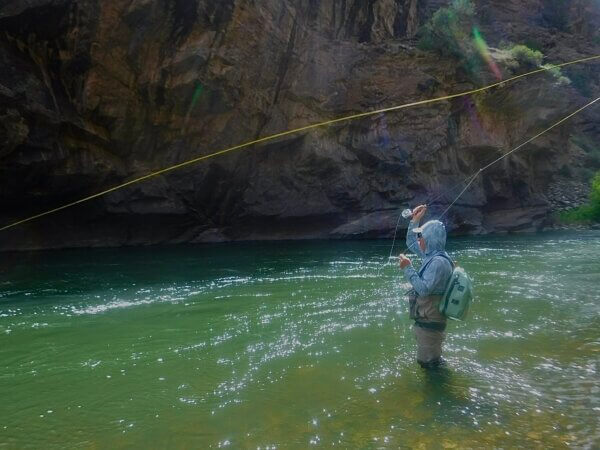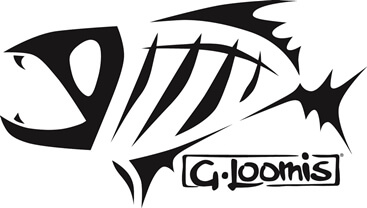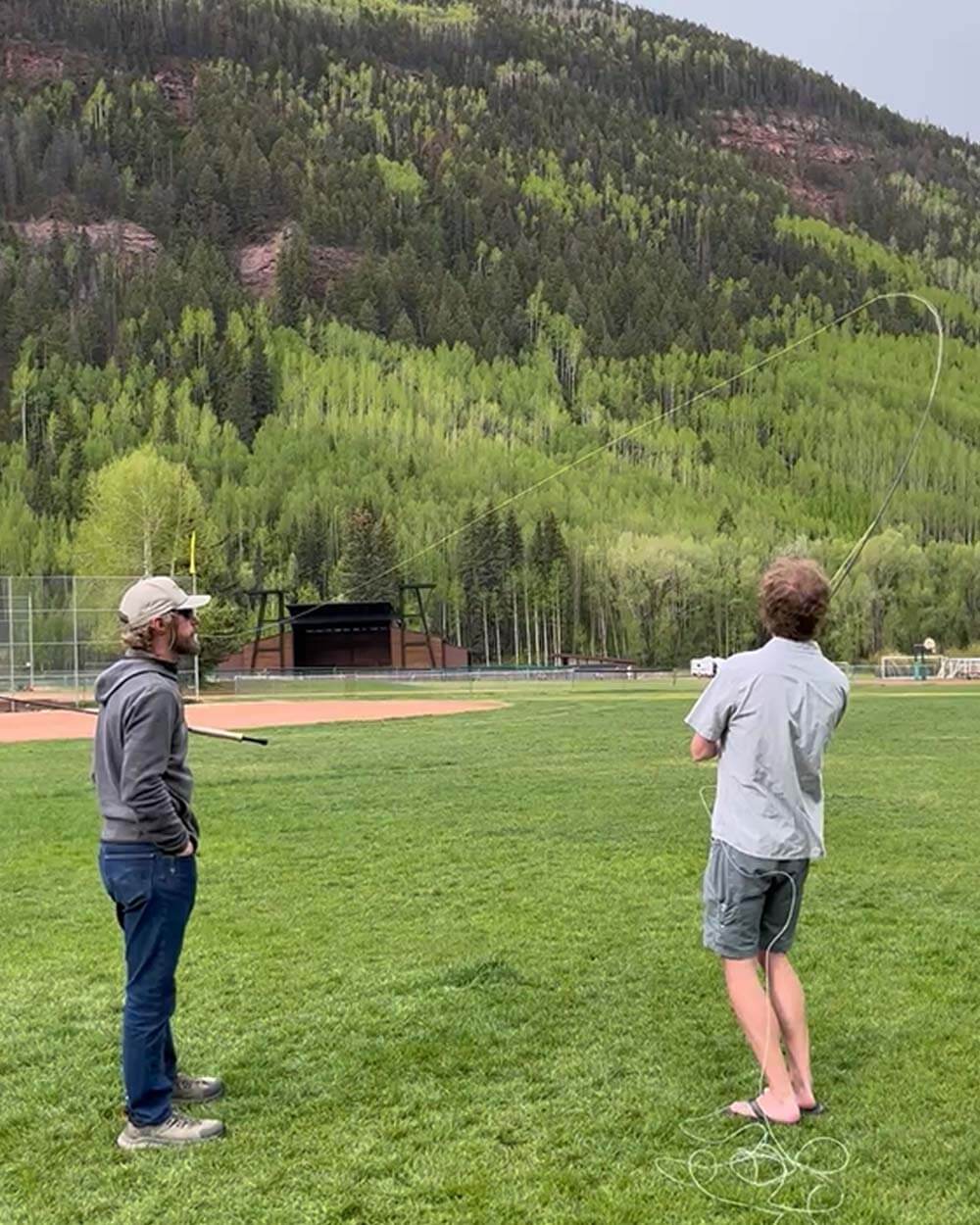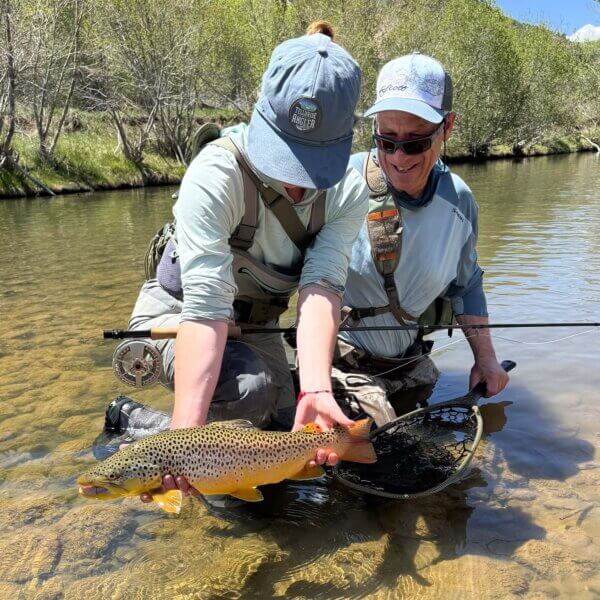Article by John Duncan with casting input from Richard Post and Parker Thompson
The Fly Rods | The Mission | Model-by-Model
| The Mission | Model-by-Model
Jump straight to your line weight
2-wt | 3-wt | 4-wt | 5-wt | 6-wt | 8-wt
The Fly Rods
Sage Classic R8
 (2025) Sage demonstrates great discipline in the Classic R8 series. Contrary to the company’s track record for designing rods that are “fast” or “faster,” the Classic R8 are the slowest action rods in this comparison. The former Trout LL series inched up into that “medium fast” category, but Classic R8 retrenches the goal to offer a series of rods that really, truly let the angler do the fishing. Sage saved its best for the most challenging models in the series, the lightest rods in which even subtle design flaws would be easy to feel.
(2025) Sage demonstrates great discipline in the Classic R8 series. Contrary to the company’s track record for designing rods that are “fast” or “faster,” the Classic R8 are the slowest action rods in this comparison. The former Trout LL series inched up into that “medium fast” category, but Classic R8 retrenches the goal to offer a series of rods that really, truly let the angler do the fishing. Sage saved its best for the most challenging models in the series, the lightest rods in which even subtle design flaws would be easy to feel.
Winston Pure 2
 (2024) From a design standpoint, Pure 2 is a complete departure from the original Pure series, though angling to be similarly classified as “medium action” fly rods. The top half of Pure series rods were stiff, or in some cases stiff and heavy, resistant to flex and forcing a deep load. Their flex profile resembled an angler bending at the waist to examine a stonefly nymph. Pure 2 rods have a much more progressive design featuring light tips and a congruous relationship between the 4 rod parts. The angler has substantially more control over the depth of flex and loop shape, empowering dry fly artistry without restraint. Lightness is a defining characteristic of the Pure 2 series, not the case with the original Pure.
(2024) From a design standpoint, Pure 2 is a complete departure from the original Pure series, though angling to be similarly classified as “medium action” fly rods. The top half of Pure series rods were stiff, or in some cases stiff and heavy, resistant to flex and forcing a deep load. Their flex profile resembled an angler bending at the waist to examine a stonefly nymph. Pure 2 rods have a much more progressive design featuring light tips and a congruous relationship between the 4 rod parts. The angler has substantially more control over the depth of flex and loop shape, empowering dry fly artistry without restraint. Lightness is a defining characteristic of the Pure 2 series, not the case with the original Pure.
G.Loomis NRX+ LP
 (2019) It’s so interesting that Loomis, which has never emphasized medium action fly rods, offers only 4 models in the LP (Light Presentation) NRX+, and they happen to be among the finest mid-flex rods on the market. Overshadowed by their fast action cousins which number 11 in the series, the NRX+ LP are like Easter eggs that may never be found. Parker and Rich repeatedly described these rods as “optimized.” The G.Loomis legacy is to make every fly rod purposeful. In the past, we have sometimes said that Rajeff doesn’t make “extra fly rods.” This is a case study.
(2019) It’s so interesting that Loomis, which has never emphasized medium action fly rods, offers only 4 models in the LP (Light Presentation) NRX+, and they happen to be among the finest mid-flex rods on the market. Overshadowed by their fast action cousins which number 11 in the series, the NRX+ LP are like Easter eggs that may never be found. Parker and Rich repeatedly described these rods as “optimized.” The G.Loomis legacy is to make every fly rod purposeful. In the past, we have sometimes said that Rajeff doesn’t make “extra fly rods.” This is a case study.
Orvis Helios F
(2024) Helios F are the fastest action rods under comparison, closest to the center of the spectrum. In our opinion, Helios F (finesse) rods are only slightly “slower” than Helios D (distance) models. On one hand this fogs their distinction, but on the other, Helios F are more versatile than many other moderate action fly rods. They are materially lighter than their peers and have a propensity for throwing tight loops. Although capable of casting great distance, anglers will notice superior feedback from a rod that flexes into the mid section with minimal material inhibition. Orvis achieved mid-flex load profile with tip sections that are stiff, but not heavy. The resilient top section encourages the rod to load into the springy 2nd and 3rd parts while commuting every vibration to the caster’s fingertips without the weight of an old fashioned fly rod.
Scott G Series
 (2017) Considered the rod to beat in many configurations, the modern Scott G Series has, until recently, been lightly challenged in the medium action category. Several models are recognized among the finest trout rods of all time, including the GS 773/4, GS 884/4 and GS 885/4, but even these legends are now being pressed by manufacturers who have used innovative materials to lighten and sensitize their new mid-flex fly rods. The excellence of G Series rods lies in the blank tapers, and in Scott’s enduring use of a semi-hollow internal ferrule, which preserves feel and load profile in rods that are designed to flex deeper than their fast action cousins. The G Series features unique rod lengths that many anglers find cleverly ideal for their purposes.
(2017) Considered the rod to beat in many configurations, the modern Scott G Series has, until recently, been lightly challenged in the medium action category. Several models are recognized among the finest trout rods of all time, including the GS 773/4, GS 884/4 and GS 885/4, but even these legends are now being pressed by manufacturers who have used innovative materials to lighten and sensitize their new mid-flex fly rods. The excellence of G Series rods lies in the blank tapers, and in Scott’s enduring use of a semi-hollow internal ferrule, which preserves feel and load profile in rods that are designed to flex deeper than their fast action cousins. The G Series features unique rod lengths that many anglers find cleverly ideal for their purposes.
Finding Your Fly Rod
At the beginning of this casting session, with 42 fly rods arrayed on Town Park lawn and approximately the same number of reels covered by a rain jacket against the softball fence, Rich said, “When we cast similar rods side-by-side, we learn something different than when we just cast through a whole series.” The point of this exercise is to help anglers discern the nuances of competing models for their specific fishing purposes. In the last 12 months, Sage, Winston and Orvis introduced new medium action fly rods. In comparing these carefully with each other, and with our old favorites from Scott and G.Loomis, we are witnessing the soul of these companies evolve in real time.
It is safe to say that virtually no private angler has the opportunity to cast all of these fly rods side-by-side. In our continuing quest to embody the ethos of “specialty shop,” this is a medium for Telluride Angler to advance knowledge among fellow anglers, provide an enduring resource, log design achievements and, most importantly, help anglers choose the future legends for their fly rod quivers. This is our continuing education.
Model Comparisons
2-weights
Line: Scientific Anglers Amplitude Trout Standard WF2
Orvis Helios F 7’6″ 2-wt: This is perhaps the most castable of the 2-weights for the angler who is more accustomed to faster action fly rods. The action and feel are more functional than fine, but almost anyone would pick up this specialized fly rod and cast it well on the first try. The choice of uplocking reel seat hardware makes this rod slightly heavier than the Scott.
Winston Pure 2 7’3″ 2-wt: A finely tuned rod possessing that addictive Winston touch, this model is the shortest of the 2-weights and therefore most specialized for creek fishing. By a degree, the Winston wins “best feel” in this category. It forms refined casting loops with an appropriate line pairing, rather than just being a “flipping stick” for close quarters fishing.
Scott G 772-4: Although longest of the 2-weights, the Scott feels lightest, thanks partially to the slide band over cork reel seat. At 7’7″, the Scott G is the most versatile of these rods, slightly more capable with a longer leader, roll cast, etc., than the Winston or Orvis. Many anglers would choose the Scott simply because lightness is their top criteria in a 2-weight, but this outstanding model also has a highly refined blank taper.

Short 3-weights
Line: Scientific Anglers Amplitude Trout Standard WF3
Orvis Helios 7’6″ 3-wt: Like the other short Helios models, the weight of the grip and reel seat cause a sense of imbalance that will bother light-touch casters but may go unnoticed by anglers who take a more aggressive swing. This is a good creek rod for anglers who drink a lot of coffee.
Winston Pure 2 7’9″ 3-wt: Lively, lovely and ideal length for versatile use on small water, this Winston is one of our three favorites in this group and slightly faster action than the Scott G or Sage Classic R8. Dripping with the “Winston fun factor,” this rod throws tight loops and left all of our casters with the impression of zippiness and line speed.
Winston Pure 2 6’9″ 3-wt: We prefer the 7’9″ 3-weight for overall polish and feel, but this is the shortest, most specialized creek rod under comparison and a compelling choice for fishing at 20′ or less under a canopy of brush or trees. Sometimes rod length is the critical variable. It needs a heavy-headed line, like the Rio or SA Creek lines, to pull through its bouncy nature and deliver your fly accurately in the pocket right in front of you.
Scott G 773-4: As Rich puts it, this is a rod with no “identity crisis.” It feels light from tip to butt and swings with zero balance or flop. The 4 parts of this fly rod seem born in the same cradle, integrated at a cellular level. Loop shape and range (0 to 40 feet) are on the pedestal of perfection for a short graphite 3-weight. Specialized for small water yet versatile enough for longer casts or the addition of a dropper to your dry fly, this is a keystone fly rod in the Scott legacy.
Sage Classic R8 380-4: This mid-length 3-weight is the slowest action rod in the group and, despite being the longest, perhaps the most effortless to cast at short distance. It is a rod characterized by elegance and touch. It does several things better than the shorter, more specialized rods in this category: roll casting, line mending and presenting long leaders. Designed with progressive flex and efficient material application, this rod is a wonderful all-purpose 3-weight that will leave you captivated in exemplary minimalism. Choose this rod over the Scott or Winston if you need greater versatility or fish with leaders over 9 feet.
Long 3-weights
Line: Scientific Anglers Amplitude Trout Standard WF3

Orvis Helios 8’4″ 3-wt: This is the fastest action rod in this category and a rod that needs to be fished with a Rio Elite Gold XP to flex through the looseness of the upper fly rod and dig into the butt section, turning it into a medium action rod that casts long leaders at distance better than others in this group. This rod is among the lightest, but shows imperfections in the relationship between its four parts.
Scott G 843-4: A rod noted for ideal balance and weight distribution along its blank, the G 843-4 is a standout among all light line fly rods. It casts from short to long effortlessly with an SA Trout Standard, although many of us fish it with a regular SA Trout or Rio Gold. The action of this rod embodies “medium, progressive action” to the letter. It’s not too long to fish in a creek, yet handles leaders up to 14 feet with ease.
Scott G 883-4: This famous Scott rod fishes highest in this line/length class while still embodying “medium action,” in our opinion. It is unmatched for tailwater and spring creek dry fly fishing. Touch and precision are remarkable and it turns over a 16 foot leader like it was born for that purpose. Fish this rod with a Rio Gold for optimal performance.
G.Loomis NRX+ LP 383-4: Best at short distance, this rod loads and casts off the tip with a quick cadence, a pea shooter that forms tight loops without much line out of the tip. This is the best creek fishing rod among these longer 3-weights. While limited with long leaders or at distance, it’s a marvelous all-purpose small water fly rod of an ideal length to fish freestones and spring creeks, mostly with dry flies. Among the plus 8-foot 3-weights, this would also be our choice for backcountry pack rod.
Sage Classic R8 386-4: This rod is a design marvel from Sage and it promises to be a legend of the future, similar to the way we regard the original Sage LL 389-4 from 40 years ago. It is the slowest action rod in this group, but tuned to perfection. It has an immaculate taper that imparts a sense of connectedness to the fly line with unsurpassed feel. When lifting the rod for the next cast, it seems to reach out 6″ further, as if clutching the line delicately with fingertips. Line release is without friction, controlled, unlimited, effortless. A goal of this article is to reveal terrific fly rods to interested anglers, hoping many will later credit us for turning them on to something magic. In Parker’s words, “This is exactly what we want from a dry fly 3-weight.” It would be hard to imagine a better rod to fish tailwaters and spring creeks where precision and delicacy are paramount.
Short(ish) 4-weights
Line: Scientific Anglers Amplitude Trout Standard WF4
Orvis Helios F 7’6″ 4-wt: For our tastes, this rod has too much weight in the reel seat, imparting a disconnected feel between the grip and graphite. This is a capable creek fishing 4-weight, however, and its medium-fast action is fundamentally well suited to fishing larger dry flies, like grasshoppers, and light dry-dropper rigs. In these cases, performance is more important than feel, but none of us would choose this rod over others in this group on criteria other than rod length.
Orvis Helios F 8’6″ 4-wt: This is a medium action rod for the fast action caster, responding best to a strong stroke with good power and range for fishing dry droppers, light nymphs under an indicator and larger dry flies. Rich puts it like this, “If you chill, it’s bouncy. Got to get this rod up on a plane.”
Winston Pure 2 8’3″ 4-wt: Perhaps the most playful and surprising rod in this category, the Pure 2 8′ 3″ 4-wt springs to life with a wonderful connection between rod and fly line, casting and fishing confidently up to about 40 feet. Within this range, it is unmatched for feel and precision. We absolutely love this unique fly rod and feel that it’s a real treasure in the sub-9-foot 4-weight category. In Rich’s words, it is “crisp with soft edges, buttery.”
Winston Pure 2 7’9″ 4-wt: Parker says, “This is a rod that will make everyone want to own a short 4-weight.” Of creek fishing length, the Pure 2 7’9″ 4-wt will handle a wide range of casting styles and line pairings, but all best fished under about 35 feet. It generates moderate line speed with complete control and wonderful response to the caster’s requests. If this rod length suits your fishing, look no further.

Scott G 844-4: Heavy compared with the Pure 2 8’3″ 4-wt, this rod is great for fishing large dry flies and dry droppers, but isn’t as sweet or elegant as the other rods in this group. Fish it with a short-headed line for best performance and to overcome its clubby feel on short distance casts.
Scott G 884-4: If you own every other rod in this group, consider buying this one, too. As Rich puts it, “If you’re the type to complain about a free lunch, you might find something wrong with this fly rod, but I can’t.” Effortless to cast, balanced, intuitive, sensitive and rangy, the G 884-4 is a contender for finest trout rod ever designed. That does not mean you should categorically choose the G 884 over the others, however. Rod length is a determining factor in utility. This is the longest rod in this group and should be considered alongside the 9-footers for versatility, whether fishing single dry, dry dropper, swung wet fly or light nymph rig. The shorter rods in this group are better creek sticks, however, and a couple are gems in their own right, but proceed with knowledge of the G 884-4.
G.Loomis NRX+ LP 486-4: This rod wins “Most Surprising” in the category. Offering the best lightness-to-length ratio among these rods, this silky caster is the easiest rod to pick up and cast well on your first toss. While not quite as even-flexing as the G 884-4, the sweet spot on this NRX+ LP 486-4 is easy to locate and optimal for casting dry flies 20-50 feet. It holds the line up nice and high with a loop that is easy to manipulate. Stability and feedback are out of this world. It will certainly handle a dry-dropper or light nymph rig, but we would choose this model on criteria of dry fly casting, in which it truly excels.
Sage Classic R8 486-4: This is the slowest action rod in the group, perhaps the least oriented to single dry flies. It has a very different personality from the Orvis and Loomis rods of identical length, both of which stand apart for their lightness. The Classic R8 486-4 doesn’t hold the line as high as its competitors, but the heavier tip drives through the cast nicely, helping deliver wind resistant or lightly weighted flies. It roll casts and mends line with aplomb, so we recommend this model over the others for nymphs, dry dropper rigs and light streamers. It is stable, confident and methodical, but not airy light.
9-foot 4-weights
Line: Scientific Anglers Amplitude Trout WF4
Orvis Helios F 9′ 4-wt: Lightest rod in the group and best tight loop dry fly caster, we would characterize this model as “medium fast,” with enough backbone to potentially fish from a driftboat (generally verbaden for all but the fastest action 4-weights). Interestingly enough, there is no 9′ 4-weight in the Helios D series. This Helios F 9′ 4-weight occupies middle ground between what you would expect from the Helios F and an imaginary Helios D 9′ 4-wt. We love the rod.
Winston Pure 2 9′ 4-wt: This rod is the slowest in the category and requires the lightest available fly line. Even the SA Trout Taper challenges the rod for stability. Perhaps a double taper would be the ticket. Regardless of line pairing, choose this rod only if you seek the most limber 9′ 4-weight for soft presentations inside of 40 feet. We recommend this rod only for advanced anglers who enjoy a puzzle.
Sage Classic R8 490-4: This rangy fly rod requires a heavier line to really groove the mid range casting. Our favorite is the Rio Gold XP, which offers top notch loop control and impressive casting efficiency at every distance. Outstanding from 25-50 feet, this rod and line combination are equally capable with long leader dry flies, dry dropper and light nymph techniques, the latter abetted by the exceptional roll cast and line mending capability of the rod. With this line, the Classic R8 is Rich’s top pick in the rod category for dry fly fishing.
Scott G 904-4: Side-by-side with the others, the G feels like it uses a little more of the rod blank. While not as feather-light as the Winston, Sage or Orvis, the G engages its fly line elegantly for dry fly casts and confidently on roll casts. We all commented that the G is a superb on-the-water fishing tool that fishes best with a slightly heavier line, such as the Rio Technical Trout or Rio Gold, but is not designed to win parking lot competitions. Fish on.
Short(ish) 5-weights
Line: Rio Elite Technical Trout WF5
Lightest and fastest action rod in this category, this model occupies similar “middle ground” to the 9′ 4-wt Helios F. A spectacular tight loop dry fly caster, it fishes best with the SA Trout Standard, Rio Gold or Rio Gold XP, all of which have somewhat shorter heads. Correspondingly, this rod can handle nymphs and small streamers better than most in this group. At least one of our casters thinks this is the single finest Orvis freshwater fly rod.
Winston Pure 2 8’3″ 5-wt: The most unique 5-weight is also among the finest rods we cast today. It is more specialized than others in the category, but absolutely superb for its purposes, which include driftboat hopper fishing, small stream hopper fishing, dry fly fishing under 40 feet and dry-dropper fishing under 30 feet. It’s a small water, tight quarters assassin, limited at distance and with long leaders but with the finest casting feel of any rod in this group, which is really saying something. This rod does not compete in versatility with the Orvis, Scott and Sage, but if you are wondering about its quality and purposefulness, we can’t overstate our affection. Remarkably, the Pure 2 is a progressive action, even flexing fly rod, in spite of its length. If you’ve ever considered a short 5-weight, the Winston Pure 2 8’3″ 5-wt is a marvel in rod design.
Sage Classic R8 586-4: The action of this rod applies to every technique: dry flies, small water nymphing, light streamers and dry-dropper. It is among the most versatile rods in the group but not the lightest, fishing most naturally with a Rio Gold XP, which digs into the mid section for a springy response. While slightly heavier than the Helios F of the same length, it has a little more command with roll casting and line mending.
This is the longest of our sub 9′ 5-weights, but somehow the extra 2″ does not make it feel any heavier. At the root of “lightness” in the G 885-4 is the fact that it simply engages its fly line better than any other 5-weight (of any length). It does more work for the caster than any fly rod in our experience. It feels like every extraneous pixtel has been removed from this rod; it casts and fishes finer than all others. Arguably the finest dry fly 5-weight of all time, it nymphs better than all but the 9-footers thanks to its progressive taper and extra couple inches. One of our casters says this is his favorite trout rod. Scott would probably choose the G 885 to carry the Olympic torch.

9-foot 5-weights
Line: Rio Elite Technical Trout WF5
Orvis Helios F 9′ 5-wt: In Rich’s words, this is “something more than a moderate action 5-weight.” Yes, it likes a relaxed casting stroke, but the Helios F is an explosive caster with enormous range, the best pure dry fly caster among these rods with plenty of butt section for nymphing and light streamers. Blank lightness and resilience is first class. We all agreed that we could feel every inch of the blank loading and recoiling, firing the fly line as if in a pipeline. It is the fastest action rod in the group, typical of the 9′ Helios F models. This is an all-around 5-weight of the highest order rather than a rod of specialized action.
Winston Pure 2 9′ 5-wt: The action of this rod is most challenging to describe in words, but all sorts of superlatives leap to mind when casting on the water. More springy than smooth, more playful than polished, the Pure 2 9′ 5-wt is for the angler who judges a rod by its feel. It requires a patient casting stroke but generates excellent line speed at short and mid distances with the undeniable air of lightness. A rod with “deep sorcery,” as Rich describes it, “and a rod for special places on special days.” It is the slowest action rod in this group and mostly for dry flies. For the record, we strongly prefer the Pure 2 9′ 5-wt to the 9′ 4-wt in the same series. This is a wonderful, mysterious fly rod.
Sage Classic R8 590-4: Like a couple of the other Classic R8s, a Rio Elite Gold XP allows this rod to “savor the bend,” in Rich’s words, releasing the caster of any strict requirements and bringing out the inherent power in the blank. It is slower action than others in this group save the Winston Pure 2, but possesses a physical solidity and confident casting rhythm that make it a very effective tool on the water. Like the Scott G 904 and G 905, this rod won’t win a parking lot contest, but on the water will prove an efficient angling instrument.
G.Loomis NRX+LP 590-4: In Rich and Parker’s estimation, this is the best “do-it-all, steady performer” in the bunch. It has less swing weight than all but the Helios F. Loop formation is intuitive and the sweet spot broad, but the NRX+LP dictates loop shape and casting rhythm more than the Scott G 905, which puts the angler more in control. It casts a dry fly magnificently yet still has enough butt section for light nymphs and small streamers. It responds well to a gentle double haul and doesn’t fold at distance. Throughout all, the NRX+LP 590-4 maintains lovely lightness, transmitting wonderful feedback to the angler.
Scott G 905-4: This “fisherman’s rod” casts semi-open loops and offers superb line control, even at distance. It is the best roll caster and line mender of the bunch, and trustworthy of delicate tippet protection. This would be our first choice for a nymphing 5-weight and a discerning selection for techy dry fly anglers. Parker points out that it loads and fishes close better than any rod under comparison and may handle an extra long dry fly leader best in class.
6-weights
Line: Rio Elite Technical Trout WF6
Orvis Helios F 9′ 6-wt: Perhaps the fastest action player in the group, this rod has a defined flex zone about 2/3 the way up from the handle. It compares most similarly to the G.Loomis NRX+LP, but favors a single dry fly and throws spectacular loops at distance. In Rich’s words, this is the most “performance oriented” rod in the group. That sounds like Sage parlance, but it’s true, the Helios F 9′ 6-wt likes an aggressive casting stroke and modest double haul. The results are impressive. Resistance to flex in the lower half of the rod makes it highly adept with sinking lines, too, because it holds line high on the backcast and has plenty of rigidity for lifting a submerged line to begin the next cast.
Sage Classic R8 690-4: Lightweight tip to butt, this rod presents as a dry fly 6-weight offering terrific loop control and long leader capability. It would be a wonderful dry fly rod for Argentina, Alaska or the Northern Rockies. This is not a rod for sinking lines or heavy nymphs, but perfectly suitable for technical nymphing on rivers such as the Green and San Juan, or shallow pocketwater streams. We all agree this is the best rod for someone seeking a modern, slower action dry fly rod. It is the slowest rod under comparison, but finely tuned and well balanced.
G.Loomis NRX+LP 690-4: This rod has classic 6-weight feel with mass and action characteristics that consistently meet an angler’s expectations. The stiff tip follows through convincingly for strong roll casts and line mends. It has a wide sweet spot starting in the 2nd section from the tip, but a firm butt section for streamers and heavier nymph rigs, or working with a sinking line. It is less progressive (even flexing) than the Scott G but seemingly lighter and more powerful. Like the Scotts, this Loomis comes with a Trout Western style grip rather than a Wells.
Scott G 886-4: Not surprisingly, this is the best rod in the group for short distance work. It is the slowest action rod under consideration, ideal for drift boat dry flies, slinging hoppers to the bank, running a light dry dropper or tossing a small streamer. On foot, the rod will do a ton of work for the angler at close distance, but lacks the reach for long line mends, cross-river roll casts or single hand Spey techniques. With a hopper at 30′, however, it’s a dagger. Fish this rod with shorter headed lines such as the Rio Gold, Gold XP or SA Trout Standard. Another point of distinction is that Scott uses a Trout Western grip rather than a Wells on their G Series 6-weights.
Scott G 906-4: This model “uses the most fly rod” but makes an impression of surprising lightness in doing so. Many 6-weights are heavy, and most medium action 6-weights are particularly heavy in the tip. The Scott G 906-4 is neither, and yet casts with the authority of a beefier fly rod. This is the result of optimal mass distribution throughout the blank and highly progressive flexing qualities. You can “feel the music,” according to Rich, as this rod flexes deeply. Scott uses a Trout Western grip on this rod, as on the G 886-4.
8-weights
Line: Scientific Anglers Amplitude Infinity WF8

Orvis Helios F 9′ 8-wt: This rod is highly differentiated from the Sage R8 Core 890. The Helios is light, springy, playful and, by far, the sweeter pure caster. Aggressive streamer lines, such as the Rio Outbound, could disrupt its casting prowess, but with a gentle tapered line such as the Infinity Taper, it is one of the most impressive rods that comes to mind, returning, in Rich’s words, “1.5 X effort input from the caster.” No other rod in this article is applicable to saltwater, but this model is among the finest bonefish rods on the planet and by far our choice for freshwater/saltwater crossover. It’s an easy rod to cast all day, ideal for warmwater applications with both floating and sinking lines.
Sage R8 Core 890-4: We chose to compare the Sage R8 Core 890 with the Helios F because it is a freshwater rod, much slower action than Sage’s Igniter and R8 Salt rods in the same configuration. Unlike the Helios F described above, this rod is designed for heavy lifting with overweighted lines, conehead streamers such as the Dalai Lama, waterlogged rabbit strip pike flies, Alaska bead rigs and other awkward kit. It lacks the lightness and fine-tuned casting characteristics of the Helios, but is more capable with the aggressive rigs of high line weight coldwater fishing. Use this rod to clear blackberries on your way to the river, then throw meat flies to silver salmon. It does not cross over well to saltwater, but it’s the rod you want if king salmon suddenly line up next to your sockeyes, or if fending off a grizzly is a realistic possibility.


Excellent, well written article on medium action fly rods.
Thanks so much!